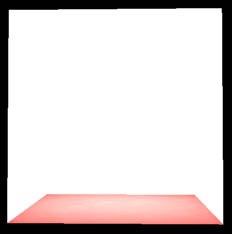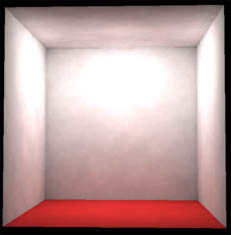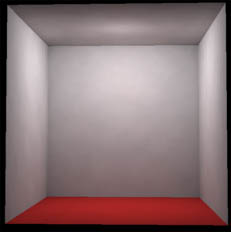3D Animation Workshop: Lesson 93: Refinements in Rendering
|
|
Lesson 93 - Refinements in Rendering - Part 3
I added global illumination by causing the point light to emit "photons." These photons travel directly to the surfaces of the walls and floors, and then are reflected onto other surfaces in the scene, picking up the diffuse color of the surfaces they visit. This contributed so much additional light to the scene that the room was completely washed out.

Lightscapse users will recognize this problem immediately. It takes alot less light to illuminate a scene if reflected light is conserved. So I cut the light intensity way down. I also made the diffuse colors of the walls and floor much darker because they were reflecting too much light back into the scene. I made a test of these new settings without global illumination, for reference.

That sure looks dark. But after the global illumination was added back in, it was brighter than I expected.

Notice how the white walls now blush with a pink glow of light reflected from the red floor. Check out the subtle and effective shadowing in the corners and the allover gentler feel. These are the signature marks of radiosity. There's a graininess here, and it took a lot of work and experimenting to get a result even this smooth by using a large number of photons. Suppressing this kind of noise is a big part of learning this new technology, and I've still got a long way to go. It's inherent in the way that Mental Ray stores global illumination at discrete point locations in the scene, in a Photon Map.
To get a result with less obvious diffuse reflection, I decreased the global illumination effect by lowering its "energy." To compensate for the loss of reflected light, I increased the amount of direct illumination by making the point light brighter. This is an interesting aspect of Mental Ray. You can adjust direct and indirect illumination independently. The result was more realistic.

To really get the idea, look at the original image without global illumination, surrounded by the previous image and another using the same setting except for a green floor. There's a satisfying, almost tangible atmosphere produced by the reflected colors.



Next time will look a little deeper and consider caustics in Mental Ray 2.1
| To Return to Parts 1 and 2, Use Arrow Buttons |
|
Created: May 22, 2000
Revised: May 22, 2000
URL: https://webreference.com/3d/lesson93/3.html


 Find a programming school near you
Find a programming school near you